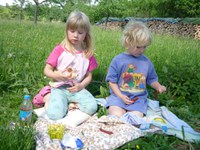Prairie Fare: Make Some Memories During National Picnic Month
(Click an image below to view a high-resolution image that can be downloaded)
By Julie Garden-Robinson, Food and Nutrition Specialist
NDSU Extension
Did you enjoy picnics when you were a kid?
I remember making my own “picnic” from time to time when I was young. I’d grab an old blanket, a cookie or two and a beverage. My dog trotted behind me, probably because I was carrying one of her blankets. I’d spread the blanket under a shady tree.
Then my dog would gaze at me with her big brown eyes and beg me for most of my cookie. I was a pushover.
Our family also had more formal picnics, where we went to state parks or visited family members at a lake. The family adventures were much more complex than my makeshift picnics. We had coleslaw, watermelon, fresh bread or buns, meat to be cooked outdoors and some kind of dessert, usually rhubarb in early summer.
Food historians have informed us that early picnics were not necessarily outdoor meals. They were more like potlucks, where the guests each brought a share of the foods.
By the mid-1800s, a “picnic” became known as a meal eaten outdoors.
July is National Picnic Month, so that’s a good time to reconnect with the memory-creating power of picnics.
Any time we move eating outdoors, we need to ponder some food safety precautions. We don’t want to make bad memories. The ants and flies are not as great a concern as the “bugs” we can’t see with our eyes.
I have a quiz for you this week to help you keep bacteria from ruining your outdoor eating.
- According to guidelines from the U.S. Department of Agriculture and Food and Drug Administration, at what temperature should cold food be maintained?
- What are at least three ways you can ensure that cold food stays cold during a picnic at a park?
- You are bringing meat to grill, beverages and salads. How many coolers should you bring?
- Why should you rinse/clean a watermelon from the grocery store before bringing it to a picnic?
- How can you clean your hands if your destination does not have a source of water?
- Your cousin decided to cook meat partially before going to the picnic. She stored it in a cooler for a few hours before finishing the cooking process. Is that a safe practice? Why or why not?
- You remembered to bring your food thermometer. To what temperature should chicken breasts reach? How about hamburgers?
8. What are two ways that you can prevent cross-contamination during the serving of marinated pork chops or chicken?
Here are the answers:
- Cold food should be kept at 40 F or below. That means storing your foods such as salads and cut fruit in a cooler filled with ice.
- To keep cold food cold, be sure to transport coolers in the car instead of the trunk, especially on hot days. Keep the cooler in the shade, and minimize the number of times that you open the cooler. Replenish ice regularly.
- Ideally, you will have three separate coolers. Have a separate cooler for beverages because beverage coolers are opened more often and could warm salads if they are kept in the same cooler. Salads and raw meat always should be in separate coolers because raw meat juices may drip on ready-to-eat salads or fruit, which makes them unsafe to eat.
- The outside of whole fruits, such as melons, may be contaminated. If you slice through the rind, you are exposing the inside of the fruit to anything that was on the rind. Always rinse fresh produce of any type before cutting and serving.
- To clean your hands, you can bring your own water in a container and soap. You also can use moist towelettes to clean your hands. Hand sanitizer is another option.
- Unfortunately, in this case, your cousin made a food handling error. Never partially cook foods and finish cooking them later. This practice encourages the growth of bacteria and the production of toxins (poisons) that could make your family sick.
- Chicken breasts should reach a temperature of 165 F, and ground beef burgers should reach an internal temperature of 160 F. Be sure to clean your food thermometer thoroughly, too, so it doesn’t become an agent of cross-contamination.
- When grilling food, be sure to have a clean plate ready to gather your freshly grilled food. If you marinated the meat, be sure you kept some marinade that did not touch raw meat.
Here’s a recipe that might remind you of childhood reunions or get-togethers. You might remember your family bringing an ice cream pail full of cabbage salad. I do.
Large Batch Cabbage Salad
Dressing
3/4 c. sugar
1/2 c. salad oil (such as canola or sunflower)
1/2 c. vinegar
1 tsp. salt
1 tsp. celery seed
1 tsp. pepper
Salad
1 head cabbage, chopped as for slaw
1 small onion, chopped (about 1/2 c.)
1/2 green pepper, chopped
1 c. celery, diced finely
You can substitute 2 small bags of chopped coleslaw mix if desired. Or you can use part red cabbage and part green for a more colorful salad.
Mix dressing ingredients thoroughly. Rinse all salad ingredients, drain thoroughly and prepare as directed. Mix in a large bowl and stir well. Cover and refrigerate overnight.
Makes about 20 servings. Each serving has 100 calories, 6 grams (g) fat, 1 g protein, 12 g carbohydrate, 2 g fiber and 135 milligrams sodium.
(Julie Garden-Robinson, Ph.D., R.D., L.R.D., is a North Dakota State University Extension food and nutrition specialist and professor in the Department of Health, Nutrition and Exercise Sciences. Follow her on Twitter @jgardenrobinson)
NDSU Agriculture Communication - June 27, 2019
| Source: | Julie Garden-Robinson, 701-231-7187, julie.garden-robinson@ndsu.edu |
|---|---|
| Editor: | Ellen Crawford, 701-231-5391, ellen.crawford@ndsu.edu |



